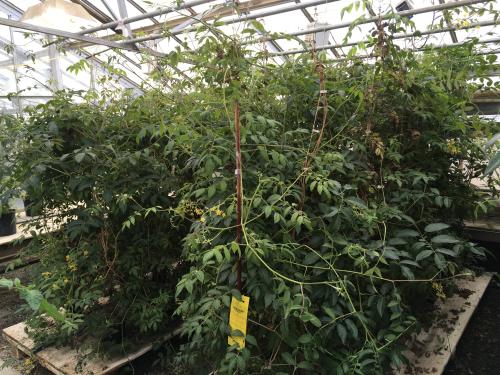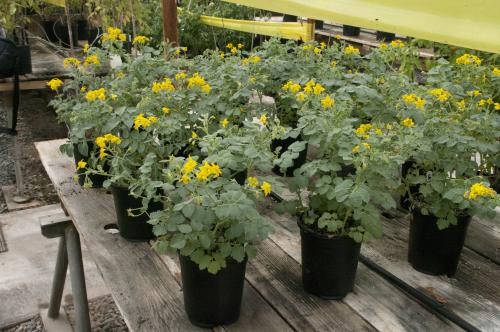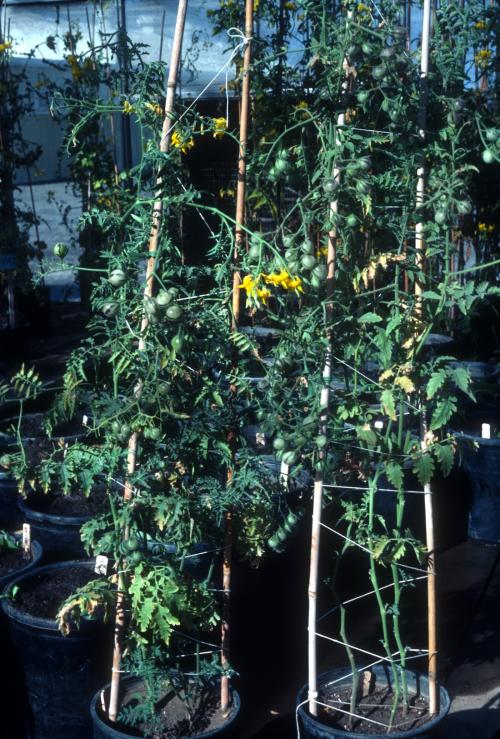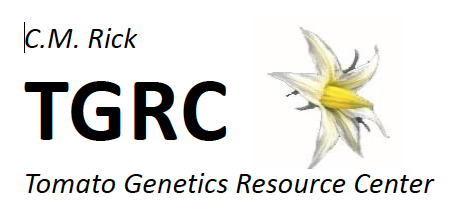| Species | Mating System | Daylength Response | Sowing (Davis) | Flowering | Pollination Method | Plants / gener | Plants / pot | Notes |
| S. lycopersicum var. cerasiforme | selfing (SC) | day neutral | February - April | year round | OP | 6-9 | (field) | |
| S. pimpinellifolium | facultative (SC) pops | mostly day neutral | February | year round | mass sib | 75 | 5 | Facultative accessions are grown in greenhouse to prevent outcrossing. |
| S. pimpinellifolium | selfing (SC) pops | day neutral | April | year round | OP | 6-9 | (field) | |
| S. cheesmaniae, S. galapagense | selfing (SC) | short day | November | Fall/Winter/Spring | self | 12-15 | 2 | Slow growing; long days suppress flowering. |
| S. chmielewskii | facultative (SC) | day neutral | May | year round | mass sib | 75 | 5 | |
| S. neorickii | selfing (SC) | day neutral | May | year round | mass sib | 15 | 5 | |
| S. arcanum | mostly SI, some SC | day neutral | June | year round | mass sib | 75 | 5 | |
S. peruvianum, S. corneliomulleri, S. huaylasense | outcrossing (SI) or mixed (SI & SC) | day neutral, some short day | June | mostly year round | mass sib | 75 | 5 | |
| S. chilense | outcrossing (SI) | short day | July | Fall/Winter/Spring | mass sib | 75 | 3-5 | Water sparingly. |
S. habrochaites
| outcrossing (SI) pops | short day | July
| Fall/Winter/Spring | mass sib | 75 | 3 | Forms edema on leaves under high humidity. |
| S. habrochaites | facultative (SC) pops | short day | July | Fall/Winter/Spring | mass sib | 50-75 | 3 | Southern SC pops more daylength sensitive. |
| S. pennellii | outcrossing (SI) or mixed (SC/SI) | day neutral | June | year round | mass sib | 75 | 5 | Use well-drained soil and water sparingly. |
| S. lycopersicoides | outcrossing (SI) | short day | August | Fall/Winter/Spring | mass sib | 75 | 3 | Up to 6 months fruit ripening |
| S. sitiens | outcrossing (SI) | short day or day neutral | August | year round | mass sib | 75 | 3 | Up to 6 months fruit ripening. Water sparingly or graft onto hybrid rootstock. |
| S. juglandifolium | outcrossing (SI) | short day | August | Fall/Winter/Spring | mass sib | 75 | 3 | 6-8 months fruit ripening. |
| S. ochranthum | outcrossing (SI) | short day | August | Fall/Winter/Spring | mass sib | 75 | 3 | 6-8 months fruit ripening. |
SC=self-compatible, SI=self-incompatible
Suggested planting times are based on each species' photoperiod preferences, as well as space and workflow criteria specific to the TGRC, and can be modified as needed. Some groups, e.g. S. lycopersicum, chmielewskii, neorickii and pimpinellifolium, thrive at almost any time of year.
OP=open pollinated under field conditions (i.e. mostly selfing); mass sib = cross pollination of all plants in a population using a bulk pollen sample.
The number of plants grown in each seed multiplication cycle are based on the TGRC's goal of maintaining genetic diversity and are provided for information only.
The suggested numbers of plants per pot (ca. 2L vol) are designed to promote flowering and limit vegetative growth by crowding plants.




